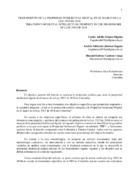Mostrar el registro sencillo del ítem
Tratamiento de la propiedad intelectual digital en el marco de la ley 1915 de 2018
| dc.contributor.advisor | Valencia Gallo, Lina María | spa |
| dc.contributor.author | Cardozo Usuga, Manuel Estiven | spa |
| dc.contributor.author | Gómez Higuita, Carlos Adolfo | spa |
| dc.contributor.author | Jiménez Zapata, Andrés Gildardo | spa |
| dc.coverage.spatial | Medellín - Antioquia | spa |
| dc.date.accessioned | 2023-09-12T16:39:37Z | |
| dc.date.available | 2023-09-12T16:39:37Z | |
| dc.date.issued | 2022-07-08 | |
| dc.identifier.issn | SSN 1808-1830 | spa |
| dc.identifier.uri | http://hdl.handle.net/10823/6957 | |
| dc.description.abstract | El objetivo general del artículo es analizar la protección jurídica que tiene la propiedad intelectual digital en el marco de la Ley 1915 de 2018 en Colombia. Para lograr este fin se han formulado tres objetivos específicos que permitirán responder a la siguiente pregunta: ¿Cuál es la protección jurídica otorgada a la propiedad intelectual digital en el marco de la Ley 1915 de 2018 en Colombia? En cuanto a los objetivos específicos, el primero de ellos se enfoca en recopilar los elementos conceptuales y jurídicos del contexto de aplicación de la Ley 1915 de 2018 en torno al manejo de la propiedad intelectual digital; el segundo objetivo consiste en identificar las garantías jurídicas a las que está sujeta la Propiedad Intelectual Digital -en adelante “PID”- y finalmente, analizar desde el derecho comparado entre Colombia y Estados Unidos, cuáles son los aspectos diferenciales que pueden tomarse en cuenta como base para manejo del objeto de estudio. En cuanto a la ruta metodológica, se propone un artículo documental, bajo una metodología cualitativa, sin intervención y con un método inductivo, donde las principales variables de análisis están relacionadas con la dinámica comercial en la que se desarrolla la propiedad intelectual digital, además de los lineamientos legales vigentes y los desafíos que se deben enfrentar en el contexto regulatorio. Como resultado final del artículo, se pudo concluir que la norma analizada (Ley 1915 de 2018) en cuanto al tratamiento específico de la PID en Colombia aún no cuenta con suficientes elementos normativos que se puedan tomar en cuenta y que puedan ser utilizados. ejercicio jurídico, sin embargo, cada día se formulan estrategias para formular un régimen que vaya de la mano con los cambios que se están dando en torno al tema, pero hay que considerar que en el caso colombiano el tratamiento de la PI en el entorno digital, bien puede basarse en la Política Nacional de Propiedad Intelectual (CONPES 4062) y otras fuentes dispersas que protegen los derechos de los creadores o cesionarios. | spa |
| dc.source | Revista Berbiquí Número 74 Revista del Colegio de Jueces y Fiscales de Antioquia Pag 47-72 | spa |
| dc.title | Tratamiento de la propiedad intelectual digital en el marco de la ley 1915 de 2018 | spa |
| dc.type | article | spa |
| dc.type.local | Artículo | spa |
| dc.type.driver | info:eu-repo/semantics/article | spa |
| dc.title.translated | Treatment of digital intellectual property in the framework of law 1915 of 2018 | spa |
| dc.subject.lemb | Derechos de autor | spa |
| dc.subject.lemb | Legislación | spa |
| dc.subject.lemb | Protección jurídica | spa |
| dc.description.abstractenglish | The intention of this article is to analyze the legal protection that property has digital intellectual within the framework of Law 1915 of 2018 in Colombia. To achieve this goal, three specific objectives have been formulated that will make it possible to answer the following question: What is the legal protection granted to Digital Intellectual Property within the framework of Law 1915 of 2018 in Colombia? Regarding the specific objectives, the first of them focuses on compiling the conceptual and legal elements of the context of the application of Law 1915 of 2018 regarding the treatment of digital intellectual property; The second objective involves identifying the legal guarantees to which Digital Intellectual Property is subject -hereinafter "PID"- and finally, analyze the legal bases of Colombia and the United States, with the intention of knowing what are the particularities most outstanding to be taken into account as a basis for handling the object of study. Regarding the methodological route, a documentary article is proposed, under a qualitative methodology, without intervention and with an inductive method, where the main variables of analysis are related to the commercial dynamics in which digital intellectual property is developed, in addition to the current legal guidelines and the challenges that must be faced in the regulatory context. As a final result of the article, it was possible to conclude that the norm analyzed (Law 1915 of 2018) regarding the specific treatment of PID can lead to uncertainty regarding the competence and application of mandatory legal provisions (national and international public order). ), however, in the Colombian case, the treatment of IP in the digital environment may well be based on the National Intellectual Property Policy (CONPES 4062) and other scattered sources that protect the rights of creators or assignees. | spa |
| dc.subject.keywords | Common goog | spa |
| dc.subject.keywords | Digital intellectual | spa |
| dc.subject.keywords | Knowledge | spa |
| dc.subject.keywords | Law 1915 of2018 | spa |
| dc.subject.keywords | Transactions | spa |
| dc.type.coar | http://purl.org/coar/resource_type/c_6501 | spa |
| dc.type.version | info:eu-repo/semantics/acceptedVersion | spa |
| dc.type.coarversion | http://purl.org/coar/version/c_ab4af688f83e57aa | spa |
Ficheros en el ítem
Este ítem aparece en la(s) siguiente(s) colección(ones)
-
Derecho - Medellín [11]

